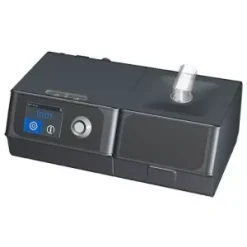What Are CPAP v BiPAP?
CPAP v BiPAP, Continuous Positive Airway Pressure (CPAP) and Bilevel Positive Airway Pressure (BiPAP) are two common forms of non-invasive ventilation therapy that treat sleep apnea and other respiratory conditions. While both devices help maintain open airways during sleep, they function differently and address different medical needs.
How CPAP Works
CPAP machines provide a continuous, steady stream of air pressure that prevents the airway from collapsing. As a result, this therapy effectively treats individuals with obstructive sleep apnea (OSA). A CPAP machine delivers a single, fixed pressure throughout the night, ensuring uninterrupted airflow and better sleep quality.
Benefits of CPAP vs BiPAP
- Effectively treats mild to severe OSA
- Reduces snoring and apnea episodes
- Enhances sleep quality and daytime alertness
- Costs less and remains widely available
How BiPAP Works
On the other hand, BiPAP machines offer two levels of air pressure: one for inhalation (IPAP) and a lower pressure for exhalation (EPAP). This dual pressure setting is particularly beneficial for individuals who struggle to exhale against a constant pressure, such as those with central sleep apnea (CSA), chronic obstructive pulmonary disease (COPD), or other respiratory conditions.
Benefits of BiPAP:
- Provides greater comfort for users who find CPAP difficult
- Works well for individuals with respiratory disorders beyond sleep apnea
- Helps those who cannot tolerate high-pressure CPAP therapy
- Supports better breathing efficiency by reducing effort during exhalation
CPAP vs. BiPAP: Key Differences
| Feature | CPAP | BiPAP |
|---|
| Air Pressure | Single, continuous | Two levels: IPAP & EPAP |
| Comfort Level | May feel restrictive for some | More natural breathing pattern |
| Best For | OSA patients | CSA, COPD, & other respiratory conditions |
| Cost | Generally lower | Higher due to advanced features |
| Prescription Requirement | Yes | Yes, often with more medical evaluation |
Who Should Use CPAP?
CPAP works well for those diagnosed with obstructive sleep apnea who need consistent airway support. Specifically, it best suits:
- Individuals with mild to severe OSA
- People who snore excessively
- Patients without additional respiratory complications
Who Should Use BiPAP?
Conversely, BiPAP benefits individuals with more complex breathing disorders, such as:
- Central sleep apnea (CSA)
- Chronic obstructive pulmonary disease (COPD)
- Congestive heart failure (CHF)
- Neuromuscular disorders affecting breathing
- Helps with breathing by cpap v bipap
How to Choose Between CPAP and BiPAP
After receiving a sleep apnea diagnosis, your healthcare provider will determine whether CPAP or BiPAP suits you best. However, several factors, including comfort, medical condition, breathing difficulties, and therapy compliance, influence this decision.
Tips for Choosing the Right Machine:
- Consult a Sleep Specialist: A proper sleep study and prescription ensure the right choice.
- Consider Comfort Needs: If a single-pressure setting feels restrictive, BiPAP may work better.
- Assess Your Condition: People with CSA or COPD may benefit more from BiPAP.
- Try a Trial Period: Some providers offer trial programs to help users test both options before making a decision.
Final Thoughts
In conclusion, both CPAP and BiPAP provide life-changing benefits for individuals with sleep apnea and respiratory conditions. While CPAP remains the standard for obstructive sleep apnea, BiPAP supports those with more complex breathing difficulties. Therefore, by understanding their differences and consulting your doctor, you can find the best solution for restful, healthier sleep.
Looking for a CPAP or BiPAP machine? Speak with a healthcare provider to get the right prescription and find the best device for your needs.


